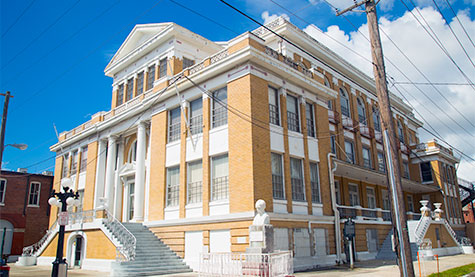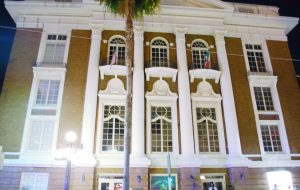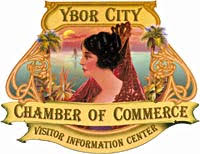Social Clubs
Cuban Club
 If the cigar factories functioned as the economic heart of Ybor City, mutual aid societies surely served as its soul. The emergence of voluntary associations among immigrants signified an organizing impulse which left its legacy in wooden dance floors, marble edifices and modern hospitals.
If the cigar factories functioned as the economic heart of Ybor City, mutual aid societies surely served as its soul. The emergence of voluntary associations among immigrants signified an organizing impulse which left its legacy in wooden dance floors, marble edifices and modern hospitals.
During the formative decades of Ybor City, Cubans devoted their collective energies to the unremitting crusade of Cuba Libre. Organizational talents funded the revolution with unceasing support, leaving a void in their community-based infrastructure. The end of the war in 1898 signaled a mass return to the homeland, only to discover the disillusionment of an unfulfilled revolution and a society in turmoil. Thousands returned to Tampa, determined to reshape and invigorate their “Little Havana” in Ybor City.
The history of Cuban mutual aid life paralleled the time line of revolution and reconstitution. The origin of El Círculo Cubano can be traced to the postwar milieu, specifically a recreational society El Club Nacional Cubano, founded October 10, 1899. The welter of labor unrest in 1901 arrested early growth, but membership climbed after the strike to 3OO in 1902. In honor of the new republic of Cuba, the society changed its name in 1902 to El Círculo Cubano. The charter expressed the hope, “To bind all Cuban residents of Tampa into a fraternal group, to offer assistance and help the sick.” The by-laws also prohibited discussion within the society of labor, politics, or religion – surely a much violated provision.
In 1907, Círculo Cubano erected its first clubhouse on Fourteenth Street and Tenth Avenue. The two-story building cost $18,000 and included most notably a 900 seat theatre. Dedication ceremonies brought out a number of American and Cuban dignitaries. In 1916 the original building burned, spurring the membership, then numbering 2,600, to rebuild with a more lasting monument. Mario Menocal, the President of Cuba, donated $2,000, while individual members pledged extra levies during a bond drive. Completed in 1918, the $60,000 structure featured a spacious theatre, cantina, pharmacy, library and a dancing floor (70 by 100 feet), lavishly decorated by Cuban painters. Imported tile, stained glass windows and marble accentuated this “cathedral for workers,” which still stands.
Cuban youth, or at least young men, were attracted to the Cuban Club. More than any of the other Latin societies, the Círculo Cubano promoted athletics. In the rear of the club, members built a gymnasium and boxing arena. Leaders also constructed a school which hosted a variety of cultural activities. “I remember as a boy going to the free art classes summer evenings at the Círculo Cubano,” reminisced Jose Yglesias.
The vicissitudes of the cigar industry affected every club in Ybor City, but none manifested such stark contrasts between good times and bad as the Círculo Cubano. In 1909, membership stood at nearly a thousand but pitched to 125 by the end of strike-torn 1910. With characteristic vigor and flux, membership revived to 3,225 by 1919 but fell again due to labor unrest to 1,602. Like a phoenix, the club thrived throughout the twenties, cresting at 5,000 in 1930. But in 1935, the aggravation of depression and dispersion saw club rolls decline to 2,492.
For more information on the history of and current events at the Cuban Club please visit their website at http://www.thecubanclub.org
Text and photos for this section provided by The University of South Florida Library, Ybor City and West Tampa Collections Special Collections Department.
Italian Club
 Immigration was forcing house of change, by which emigrants were recast with new identities. Emigrants left the Magazzolo Valley in Sicily as Stefanesi and Alessandrini, to reemerge in Ybor City as Sicilians and Italians and later Latins. The mutual aid society played handmaiden to this conversion.
Immigration was forcing house of change, by which emigrants were recast with new identities. Emigrants left the Magazzolo Valley in Sicily as Stefanesi and Alessandrini, to reemerge in Ybor City as Sicilians and Italians and later Latins. The mutual aid society played handmaiden to this conversion.
Founded in April 1894, L’Unione Italiana originally included 116 Italian and eight Spanish immigrants. The charter stated that the organization’s purpose was “to aid such members of said association as may become sick and to provide for the paying of the burial expenses of such members as may die, and to promote fraternity, charity and social intercourse among its members.” Article Seven declared, “This society is founded exclusively by Italians,” but it permitted members of other groups … as long as they were of good moral standing and aged between fourteen and fifty.” In a none-too-subtle show of indifference to organized religion, the society’s by-laws set a precedent (still followed) that the annual and monthly meetings of the membership would be held the first Sunday of each month at 10:30 a.m.
L’Unione Italiana drew its leadership from the ranks of individuals known as prominenti, Bartolomeo Filogamo, the society’s first president, reflected that classic profile. He had left the Old World in 1885 as an early pioneer, settling in New Orleans before arriving in Tampa in 1889, ahead of the major immigrant stream. He quickly exploited the Ybor City economy, as his linguistic and financial talents assisted his elevation to bookkeeper at the Pendas and Alvarez cigar factory. He befriended the firm’s owner, Enrique Pendas, who pioneered the founding of Centro Español. When an embryonic Italian settlement emerged, Filogamo brought Enrique Pendas and seven other Spaniards into the charter membership of L’Unione Italiana, and he consciously modeled the organization after Centro Español. Although born in the Sicilian town of Castellammare del Golfo, which was not a major source for Tampa’s Italians, Filogamo was nonetheless tapped by Sicilians from the Magazzolo Valley to head the new venture. Filogamo’s organizational talents and his connections with the Spanish elite made him an effective first president. Still, the choice of an “outsider” as head of this particular society seems remarkable, given the heavy predominance of Stefanesi and Alessandrini in the early colony. Filogamo guided L’Unione through its first decade, followed by Filippo F. Licata who held the reins of power for the next twenty years, 1906-1924.
From its inception, L’Unione avoided the petty, factional battles which drained the energies of so many other Italian societies in other cities. L’Unione served as a collective umbrella, not only for immigrants and children from the Magazzolo Valley, but also for smaller numbers of other Sicilians and Italians, and even clusters of Spaniards and Cubans, who for economic, marital or other considerations, were drawn to this particular banner.
L’Unione, with its reverence for social custom and its deliverance of mutual aid, quickly came to play a paramount role in Ybor City’s Italian community. In this sense, L’Unione Italiana paralleled its dynamic institutional counterparts, Centro Español, Centro Asturiano, Círculo Cubano and La Unión Marti-Maceo. Judging from institutional records, oral interviews and documentary reports, one estimates that between the 1890s and 1930s, 90 percent of Ybor City’s first-and-second generation men belonged to at least one of these societies. “My father belonged to L’Unione,” boasted Dominic Giunta. “Before he ever bought a loaf of bread, he paid his dues. We grew up appreciating that fact.
The mutual aid society appealed to the most basic of human instincts. Immigrants, terrified of dying unattended and unnoticed in a strange land, banded together to formalize the rituals of life and death. L’Unione institutionalized Sicilian funeral customs while adapting them to Ybor City. In 1900, the club purchased and dedicated an Italian Cemetery two miles north of Ybor City, at Twenty-sixth Street and Twenty-third Avenue. The cemetery with its imported cypress trees, inset ceramic photographs on gravemarkers, tombstones inscribed in Sicilian and Italian script, bears a near exact resemblance to the hallowed grounds in Sicily it sought to duplicate. In the early years, each club member contributed one dollar to the bereaving family; later, the club provided a $300 death benefit. By 1928, L’Unione, strengthened by increasing numbers of second-generation members, instituted a revised death plan whereby families received $975 in benefits.
Bolstered by steady streams of newcomers and confident of the future, the leadership of L’Unione in 1910 announced plans for a permanent clubhouse. Dedicated on Columbus Day, 1912, the $40,000, three-story structure stood on Seventh Avenue between Seventeenth and Eighteenth Streets. The brick building featured an athletic room and theatre. Paul Longo, past member and president, once reflected as to its meaning in 1912. “I thought, my God, in Sicilia only the Church and Counts build such a monument.”
The monument, intended to last three generations, stood three years before a fire destroyed everything. Members unhesitatingly pledged to rebuild, across the street at Seventh Avenue and Eighteenth Street. Construction began in April 1917, at a time when Little Italies elsewhere were channeling their community resources into bond drives and Red Cross benefits in support of World War I.
The erection of the new L’Unione signified a profound commitment to Italian community life in Tampa and an important benchmark in the consolidation of community. Built in an Italian renaissance style, decorated with classical columns, terra cotta relief, and a profusion of marble, the clubhouse stands as an impressive monument to immigrant achievement. The building included a magnificent theatre with an auditorium and balcony (later converted to a movie theatre), a spacious dance floor, library, cantina, bowling alley and recreational rooms. With furnishings, the building cost $80,000, a considerable sum for the time.
The Italian Club, as social center for the community, performed myriad roles for its members. For Italian men, the cantina served as a sanctuary, a male bastion where a woman never casually entered. Like their Spanish counterparts, Italian men retreated to the club for after-dinner socializing. “We used to come here during the week, all the people who live around here,” remembered Joe Maniscalco. “They come here to the club and play dominoes, briscola, scoppa – until twelve, one o’clock at night! This [club] used to be paradise.”
If the gaming tables of the cantina lured a male clientele, the banner of L’Unione attracted families, especially for group excursions. Picnics, outings and festivals allowed the club to raise impressive amounts of revenue and bring out huge crowds. In 1924, the club enjoyed a mammoth picnic to celebrate a membership drive which successfully enrolled a thousand new recruits. L’Unione’s 1,800 members, with their families, gathered at the farmstead of F. M. Antuono and posed for a photograph which still hangs at the club today.
On Saturday evenings, the polished dance floor of L’Unione came alive. “Talk about dances!” exclaimed Nina Ferlita. “We used to have some of the most beautiful dances … cabaret tables all over the hail. And they would have Cuban music, Italian music.” When the second generation began to fraternize the club, two bands often entertained the crowds, one playing more sedate tunes for the parents; the other performing the more rhythmic rumba and samba for the younger set. “I remember when the Italian Club was built,” reminisced Alfonso Lopez, the son of Spanish immigrants. “It was a nice club … we [Spanish kids] used to go to dances there quite a lot as young boys, the Italian Club, also the Centro Español, Centro Asturiano, and the Cuban Club. It was a perfect setup for a young boy, because you could go there and didn’t have to take a date…. You could always find some girls that were chaperoned.
L’Unione transcended the dance floor and domino tables; it inculcated a vigorous cultural life. The library housed a diverse collection of literature, especially strong in its emphasis in working-class and leftist themes. Many of the classic works by Michael Bakunin, Victor Hugo and Peter Kropotkin were available in leather bound editions, reflective of the honored places they occupied in the minds of club members.
A vigorous theatre developed at the Italian Club. The auditorium for L’Unione attracted a number of prominent opera stars. “We had a theatre, a beautiful theatre,” boasted the cigarmaker and opera aficionado Joe Maniscalco. “We used to get the operetta from New York. The locals also formed a theatre to work with them.” Ybor City became a favorite stopping-off spot for stock companies and performers touring Cuba, such as Pasquale Vittore and Maria D’Amore. The bilingual nature of the Italian community permitted L’Unione’s membership the enjoyment of attending the Spanish-language theatre at the other clubs and also of appreciating plays performed in Spanish at L’Unione.
For more information on the history of and current events at the L’Unione please visit their website at
http://www.italian-club.org.
Text and photos for this section provided by The University of South Florida Library, Ybor City and West Tampa Collections Special Collections Department.
